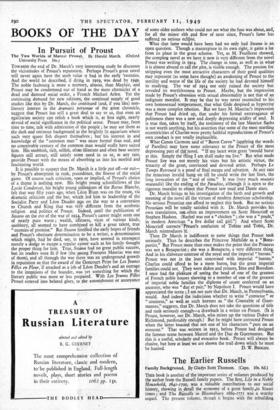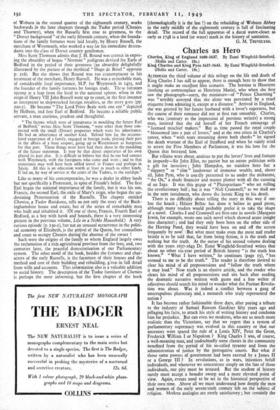The Earlier Russells
Family Background. By Gladys Scott Thomson. (Cape. 10s. 6d.)
Tms book is another of the important series of volumes produced by the author from the Russell family papers. The first, Life in a Noble Household, 1641-1700, was a valuable contribution to our social history, showing in detail the economy of a great family„in Stuart times ; and The Russells in Bloomsbury 1669-1771 was a worthy sequel. The present volume, though it begins with the rebuilding
of Woburn in the second quarter of the eighteenth century, works backwards in the later chapters through the Tudor period (Chenies and Thomey), when the Russells first rose to greatness, to the " Dorset background "of the early fifteenth century, when the founda- tions of the family fortunes were laid locally, by Henry Russell, the merchant of Weymouth, who worked a way for his immediate descen- dants into the class of Dorset country gentlemen. -
Miss Scott Thomson admits that J. H. Round was correct in expos- ing the absuldity of bogus " Norman " pedigrees devised for Earls of ;Bedford in the period of their greatness (an absurdity delightfully illustrated by the picture of the mythical "Hugo de Rosel " opposite p. 216). But she shows that Round was too contemptuous in his treatment of the merchant, Henry Russell. He was a remarkable man, of considerable local importance, M.P. for Weymouth in 1425, and the founder of the family fortunes by foreign trade. Thcse fortunes sprang at a leap from the local to the national sphere, when in the reign of Henry VII John Russell went up to court, in the first instance as interpreter to shipwrecked foreign royalties, as the story goes (pp. 200-1). He became "The Lord Privy Seale with one eye" depicted by Holbein, and first Earl of Bedford. He became a reliable public servant, a man cautious, prudent and thoughtful.
"The factors which were of importance in moulding the future Earl of Bedford," writes Miss Scott Thomson, "were other than those con- nected with the small (Dorset) properties which were his inheritance. He had an inheritance of another kind. Behind him lay the accumu- lated experience of a family, engaged in foreign trade; playing their part in the affairs of a busy seaport, going up to Westminster as burgesses for that port. These things must have had their share in the moulding of the future statesman. It may be that direct experience of his own played its part also. It is difficult to believe but that he too had contact with Weymouth, with the foreigners who came and went ; and to that experience may well have been added travel in France and perhaps .in Spain. All this is an education worth at least as much as other kinds. It led on, by way of service at the court of the Tudors, to the earldop."
Like so many of his contemporaries, he was a dealer in abbey lands but not specifically a Protestant, in spite of Froude's belief. The first Earl began the national importance:of the family, but it was his son, Francis, the second Earl, the exile of Mary's reign, who began the un- deviating Protestantism of the Russells. The chapter entitled Chenies, a Tudor Residence, tells us not only the story of the Buck- inghamshire house and estate, but of the series of remarkable men who built and inhabited it. (Of one of these, Francis, Fourth Earl of Bedford, as a boy with hawk and-hounds, there is a very interesting picture in the previous volume, Life in a Noble Household.) A very curious episode (p. 130-I), but not an unusual occurrence in the politi- cal economy of Elizabeth, is the arrival of the Queen, her counsellors and court to occupy Chenies dining the absence of the owner !
Such were the origins of the family to whom England largely owes the reclamation of a rich agricultural province from the fens, and, two centuries later, the peaceful democratisation of our Parliamentary system. The other motif of the book, besides the fortunes and char- acters of the early Russells, is the furniture of their houses and the method and cost of their building and rebuilding, Oren in full detail from wills and accounts. This information also is a valuable addition to social history. The description of the Tudor furniture of Chenies is perhaps the most informing, but the first chapter of the book
(chronologically it is the last !) on the rebuilding of Woburn Abbey in the 'early middle of the eighteenth century is full of fascinating detail. The record of the full apparatus of a ducal water-closet as early as 1748 is a land (or water) mark in the history of sanitation.
G. M. TREVELYAN.







































 Previous page
Previous page